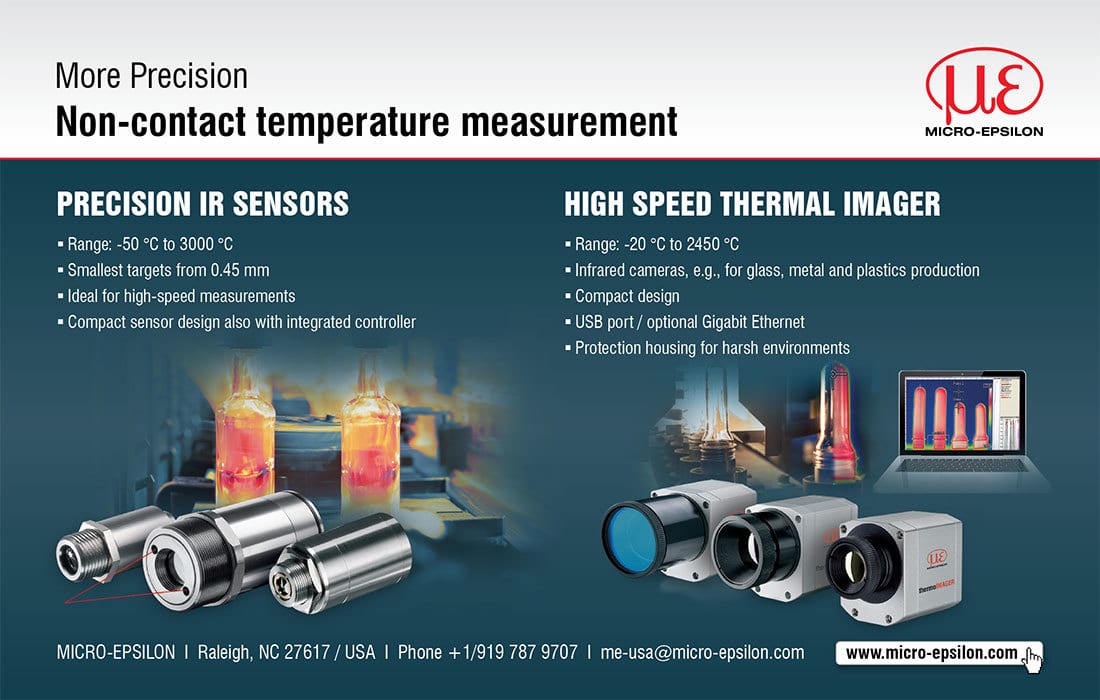cameras
cameras
Vision & Sensors
V&S
All About Machine Vision
Cameras
Working with camera and vision technologies is becoming more popular every year across many industries - and the pace of innovation has never been faster, experts say.
By Genevieve Diesing
Cameras are the eyes of visual quality inspection systems. Cameras and machine vision technologies help to improve quality by automating processes, making them more precise and repeatable, while also boosting their speed and throughput.
Camera-based inspection also enables nonstop, consistent quality assessments, which enables rejecting defects and detecting process deviation, says Alexis Teissie, product marketing manager at LUCID.
“For quality control applications, machine vision systems and cameras can be particularly adept at a variety of tasks from gaging, guidance, identification, and inspection,” says Riana Sartori, senior manager, machine vision products, Teledyne FLIR. “Machine vision cameras are used to also provide a level of automation, consistency, reliability, and accuracy beyond the ability of human perception, 24 hours a day. Furthermore, machine vision cameras are well used in robotics and are ideal for jobs that are dirty, dangerous, or monotonous for human workers.”
The images they provide are perfectly matched to the requirements of the parts they inspect, says Jeremy Bergh, president, North America, IDS Imaging Development Systems.
“[They] allow for higher speed and efficiency of the inspection as well as tighter tolerances compared to human visual inspections,” Bergh says.
Compared to tactile sensors or position sensors, cameras are more flexible and enable manufacturers to execute complex automation tasks while simultaneously relaxing the constraints imposed on the machine’s mechanical design, says Teissie.
“For instance, many robotic pick-and-place applications can be made simpler and with wider preposition tolerances by adapting camera-based sensing able to cope with a variety of object positions and orientation,” Teissie explains.
Ultimately, machine vision systems and cameras can be more precise and accurate than human perception, especially at high speeds.
For some applications, such as metrology, humans simply don’t have the ability to interpret and gauge the high accuracy required, says Sartori.
Cameras also don’t become tired or need to be trained.
“In other instances, the ability to use cameras can help reduce manufacturing costs, from high tech products such as smartphones to packaged foods,” Sartori says. “Where speed is paramount, such as inspecting the fill level of bottled beverages traveling at high speed as part of quality control inspection, machine vision cameras are ideal.”
Choosing the right camera isn’t always a straightforward task, experts say. Potential users must consider many variables, including, but not limited to environment, lighting, speed of process, mounting location, and the size and distance of parts.
“Thankfully there are many good machine vision resources out there,” says Bergh. “Besides our team here at IDS, there are distributors, system integrators and competitor companies that are capable of helping to choose the right camera and accessory components.”
Camera selection will depend on the camera’s actual application and required precision, Teissie says.
“In broad terms, a machine vision camera is usually selected based on its image sensor characteristics, such as resolution, frame rate, spectral response, image quality and optical performances, [as well as its] digital interface and associated cabling requirements, such as cable length, power delivery capability, mechanical specifications for the cable and connectors, etc., and its built-in processing features,” says Teissie.
The goal for the vision system designer is to strike the right balance between built-in functionalities, ease of integration, and reliability of operation, Teissie explains.
“There are several factors that must be considered when determining the appropriate camera(s) for a given application,” Sartori says. “For most industrial applications, the ability to control and trigger the camera requires the use of machine vision technology versus a ‘regular’ camera.”
Also, Sartori says, cameras are often used in environments with vibrations, or where the camera is constantly moving, such as inside a robot arm. Operators expect them to operate constantly and work reliably for five to 10 years.
“Inspection and automation tasks can now be carried out closer to the actual process.”
“Once those physical demands for quality and reliability are met, the next most important factor is understanding the level of accuracy required, which dictates the spatial resolution needed, often determined in pixels per inch,” Sartori says. “Resolution is typically one of the most important determinants of cost.”
As technology presses forward, it drives faster speeds, higher resolutions and more image processing options, including advancements in 3D and artificial intelligence (AI) capabilities.
Bergh and Teissie both point to the popularity of deep learning and AI, which combined with on-camera edge analytics, offer a new paradigm for vision system developers.
“Inspection and automation tasks can now be carried out closer to the actual process in addition to opening up new process monitoring and improvement opportunities,” Teissie explains.
Over the last few years, machine vision cameras have expanded beyond the visible light spectrum and new sensing technologies such as polarization imaging, short-wave infrared (SWIR), and event-based vision, Teissie says.
“Whereas those technologies were previously confined to the academic and scientific worlds, their adoption in a standard industrial camera format have unlocked a wide field of potential applications in the industrial sector,” Teissie explains.
The mobile and automotive industries have played a crucial role in driving sensor innovation from size, weight, cost, and resolution perspectives, Sartori says. Thanks to advances in imaging processing, camera manufacturers can meet the increasing performance requirements of these industries, and more, but in smaller form factors.
Working with camera and vision technologies is becoming more popular every year across many industries and the pace of innovation has never been faster, experts say. Teissie points out that keeping track of the latest sensor technologies and computing trends is a challenge and makes it essential for camera users to have a thorough approach when selecting their next vision system.
As Teissie says, “The camera itself and its ecosystem and potential upgrade path need to be considered carefully to account for future process improvement.”

